This weekend I went hiking in the mountains west of South Park, Colorado. In real life, South Park is a giant, high-elevation plain full of cattle surrounded by legions of snow-capped mountains — NOT a mountain town full of witty, potty-mouthed kids and their clueless parents (although Fairplay, CO, within South Park is indeed home to “South Park High School”). In Colorado-ese, a “park” is simply a high-altitude meadow or treeless plain. There is also a Middle Park — home to the ski resort confusingly named Winter Park — and a North Park, which touches the border with Wyoming and is home to Walden, the “moose-viewing capital of Colorado”.
The biggest treat of a 15-or-so mile hike I did was getting to hike through a real, honest-to-goodness bristlecone pine forest. It was my first time. These can power through 3- to 5,000 years on stony crags in California and Nevada, making them the oldest single living organisms on Earth. Their entire bodies possess this unearthly Sophia-Loren-like aging prowess; unlike most pines, whose needles last two to four years before they’re shed, bristlecone pine needles may hang around for 45.
I had never seen one up close before, and here was a whole forest of them. Dark olive green and indeed quite bristly, they seemed like stiff, bony, but still somehow elegant codgers of the pine world. I snatched a fallen cone in passing. I examined its scales. And sure enough — bristles.
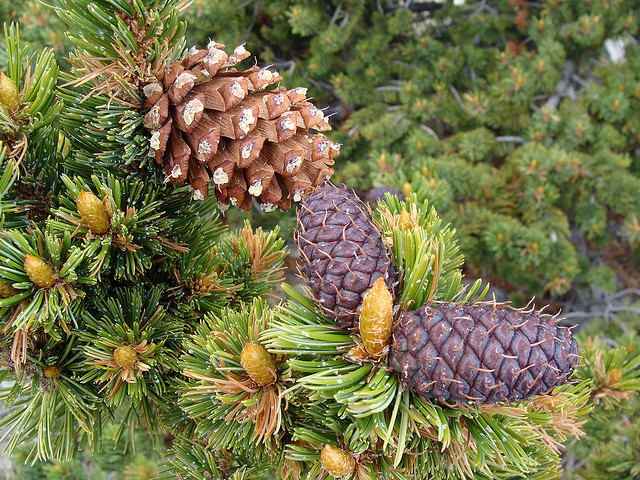
How the bristlecone pine earned its name. As you can see, the bristles shrink as the cone ages. Not my photo -- I was too busy slogging uphill. Creative Commons mcsboulder. Click for link.
In spite of all this awesomeness in just one of their number, plants get no respect. And conifers . . . well, conifers get made into toilet paper (in fairness, so do some deciduous trees). But cone-bearing trees — gymnosperms to botany nerds — are way cool. From their strappy or needle-like laugh-at-dehydration leaves to their incredibly beautiful bordered pit-pocked water-transporting wood cells called tracheids, to their stranglehold of Earth’s real estate from 50-70 degrees North, conifers deserve respect. But for today, let’s focus on their cones. They’re not all bristly, but there’s more to conifer cones than meets the eye.
Gymnosperms are so called because they make “naked seeds”. Not spores like mosses or ferns, nor seeds embedded in fruit like flowering plants. Just seeds — which are themselves plant embryos packaged with a little nutrition to get them going when they land in a spot with promise. Growing up, I was mystified by pine cones because I could never find the seeds. Was the cone the seed? Did the seeds even exist? As it turns out, the seeds are missing by the time you examine a cone because they have usually taken wing on the little sails they sprout. Each pine cone makes two seeds per cone scale, and sometimes you can see the outline of where the pair once sat if you look at a cone carefully.
Here you can see the lighter shadows of where the two seeds once nestled, with a dark stripe between them.
And here are what winged pine seeds look like. The oil-rich pine nuts you may have eaten are also pine seeds — packed with much more food and lacking obvious wings. Instead, birds called nutcrackers do the dispersal job, stuffing their seed pouches silly (they can cram a hundred or more in there) and burying them hither and yon. Like squirrels, they inevitably forget where they stashed some, which germinate where they’ve conveniently been planted.
Cones actually come in two different flavors, too. The cones I’ve just shown are all females. But there are male cones as well. These are the ones that shed pollen by the lungful and explode in a cloud of yellow dust when you whack a pine branch in spring. (I wrote about pine pollen here).
Male cones are not so heavily armed and fortified as female cones. In fact, you’ve probably seen them before without knowing what you were looking at. They drop in hordes from the tree in spring, once all their pollen has exceeded its use-by date.
The male cones shed pollen — really immature haploid plants called microgametophytes, but that’s another fascinating story — that lands in the cones. There, in a truly byzantine process, it takes another 15 months just for the sperm now sealed inside the cone to eventually burrow in through a germ tube from the pollen grain to reach the eggs, and a full two years before the cones open to release their seeds. The pines hold their cards close.
You’ll notice that male and female appear quite different. The females have the bauplan of a well-armored samurai, while the male cones are so wimpy and evanescent that many people are oblivious to their existence. As it turns out, this wasn’t always the case.
A report published online in February in the Proceedings of the Royal Academy B found that, looking as far back as evolution of pines in the Pennsylvanian era some 300 million years ago, female cones were no huskier than males. But in the Jurassic, some 100-150 million years later, they’ve slowly grew stouter and more tamper-proof while seeds and male cones have remained the same size. For a gorgeous photo of a slender fossil female cone next to modern males and females, see here (click the image to enlarge it).
Over a hundred million years of stasis followed by a sudden increase begs the question: why? Well, when things get ouchier and more prone to causing indigestion, one can generally infer that something something started eating them with abandon. That something could have been newly evolved long-necked dinosaurs like Diplodocus. Or it could have been branch-bombing early birds or mammals, or a fiendish new mastication tactic on the part of insects. In any case, once the arms race began, it appears female cones have seen no reason not to continue fortifying, steadily increasing in size to this day. With over two years from pollination to seed deployment in which to defend the young’uns, can you blame them?
In other pine cone news, a paper in PNAS reported in December that those flimsy male gymnosperm cones may well be the ancestors of every flower you see. They looked at which genes are switched on in flower development and compared this to the genes switched on in male and female cone development. In flowers we consider to have retained the forms of the first to evolve — like water lilies — there is often a gradation between petals and stamens(the things that release the pollen), with some petals doing double duty as boy bits (see also here).
They are arranged spirally, just like the arrangement of the “microsporophylls”, or things holding the pollen sacs on the male cone (go back and look). The researchers found that the same genes that govern male cone formation seem to be guiding the development of floral perianths (the petals+stamens) in these early flowers. Further, the genes controlling the development of the tepals and stamens seem to cover a large spatial area and gradually intergrade with each other, just as in male cones. The development of the flowery female bits (the carpels), on the other hand, seem to be governed by the same genes that shepherd female cones to maturity.
Unlike more derived (evolved) flowers like, say, orchids, or poppies, where there are very specific genetic programs for very discrete organs (stamens and petals in these flowers are nothing alike), in these early flowers, it seems as though sepal (another sort of flower part that often encloses the petals), petal, and stamen are still being “sorted out”, in the words of one of the authors. Clearly distinct floral organs goverened by clearly distinct genetic programs evolved later.
So it appears that somehow, somewhere, a male gymnosperm cone got a bit confused and some genes were flipped on that were supposed to be flipped off. Female parts formed amidst the male. And once that happened, some of the male cone scales began mutating in ways that changed their size, shape, and function. Through natural selection, some bigger, showier male scales became sterile as they specialized in attracting pollinators — a new concept, that. With carpel-seeking insects to do your reproductive bidding (rather than just relying on the deveil-may-care wind, as living gymnosperms do), one may presume reproductive efficiency shot up. Not long after, we have Darwin’s Abominable Mystery: the sudden hegemony of flowering plants, which went on to take over the world*. Today, 90% of land-based plant life makes flowers.
But some of them could still almost make cones. “Primitive” flowers like water lily or avocado still carry around all the genetic equipment they’d need to turn a pine cone — eventually — into a petunia.
___________________________________________________________
*Canada and Russia excepted. It seems flowering trees are no exception to the rule: never get involved in a land war in Asia.

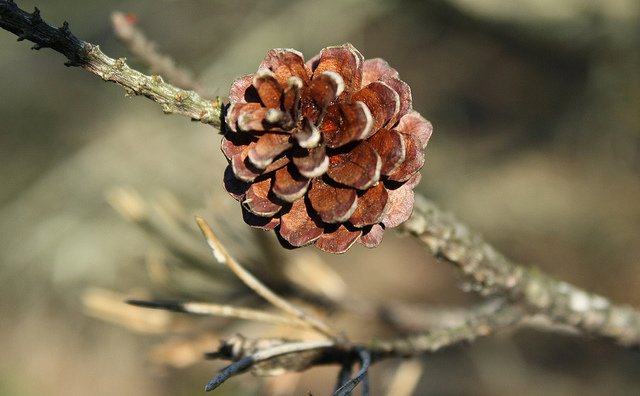
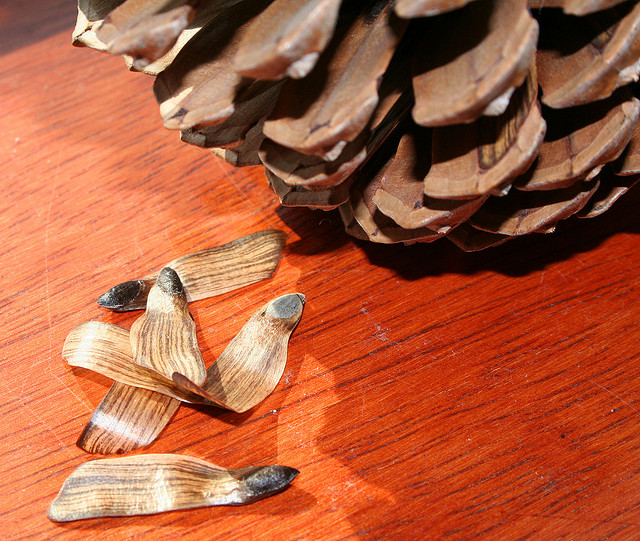
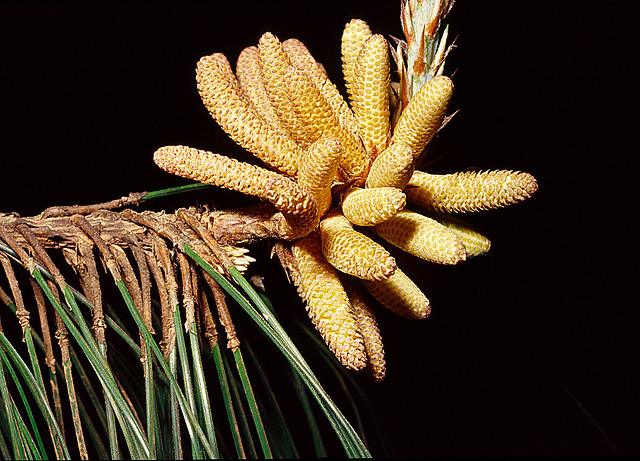
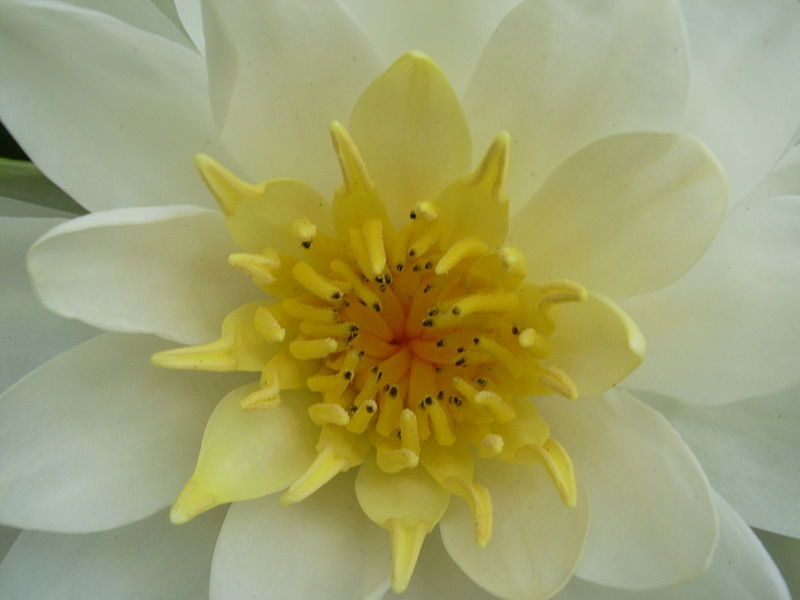

{ 1 trackback }
{ 5 comments… read them below or add one }
It is probably more accurate to say that the really long loved specimens inhabit the Great Basin rather than California. Most of the old trees are in Nevada. I’ve been to groves in the White Mountains of California and the Snake Range and Currant Mountain in Nevada.
Another interesting characteristic of the Bristlecone is that they only shed needles every 30 years or so. I think that is the longest period of any conifer.
Good point. I’ve amended the text.
And yes — my college botany textbook said it’s even longer — 45 years! Remarkable either way.
There’s actually two different kinds of bristlecone pines, the intermountain and the rocky mountain. The intermountain pines claim the title of oldest living organism at just over four thousand years, where as the rocky mountain pine only has an organism of about 1,000. The rocky mountain pines can survive harsher conditions, however, higher altitudes and more acidic soil. I love these pines because they grow in some of the harshest environments in rocky soils and keep on thriving.
I was looking up the name for the “petals” of a pine cone for a poem I was writing. Is “scale” the word I want–the shingle without the seed? The poem is about layering peach halves in a Mason jar (among other things)–which reminded me of the way the scales are layered in a pine cone. At any rate I enjoyed your exuberant writing.
Yes, scale is the word you want! Sorry it took me so long to reply.